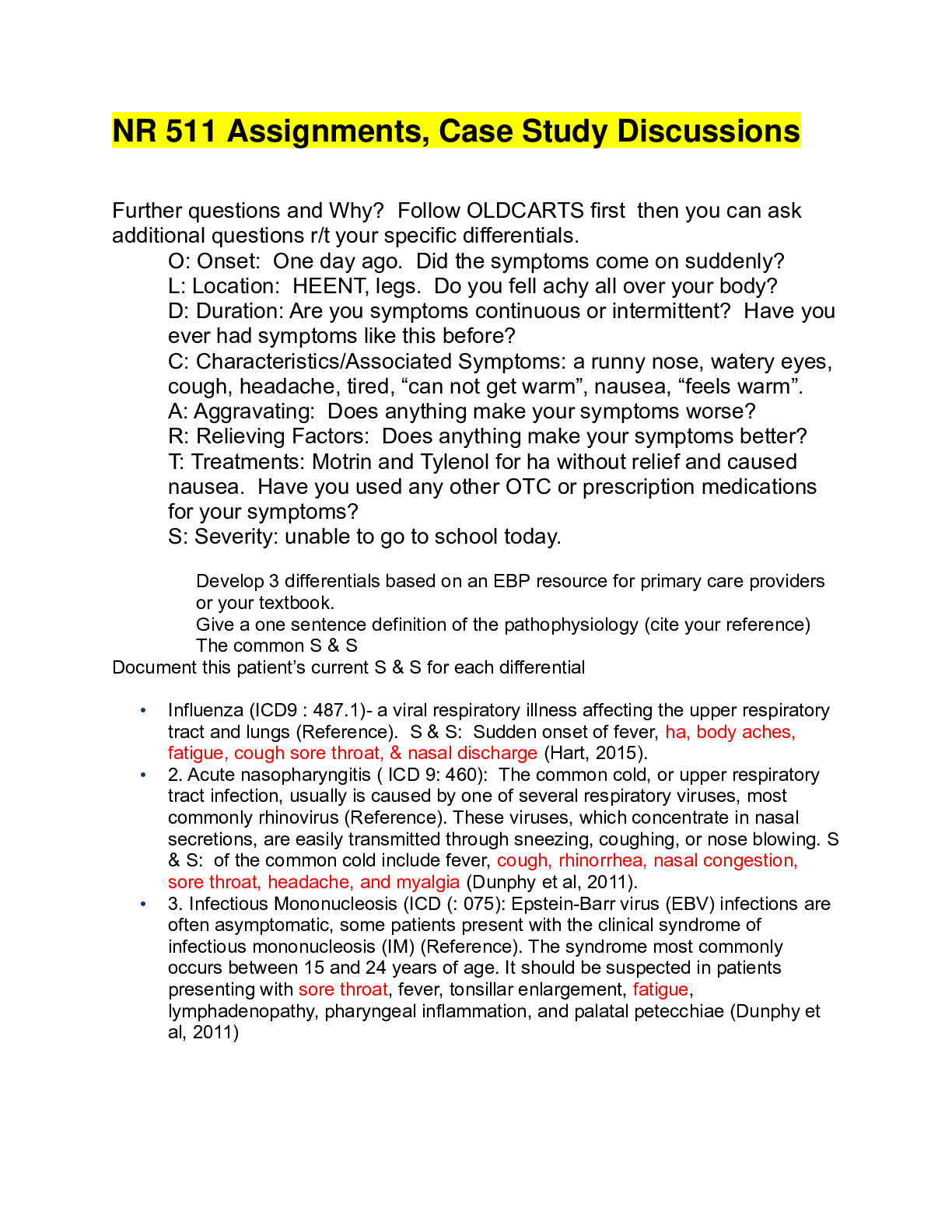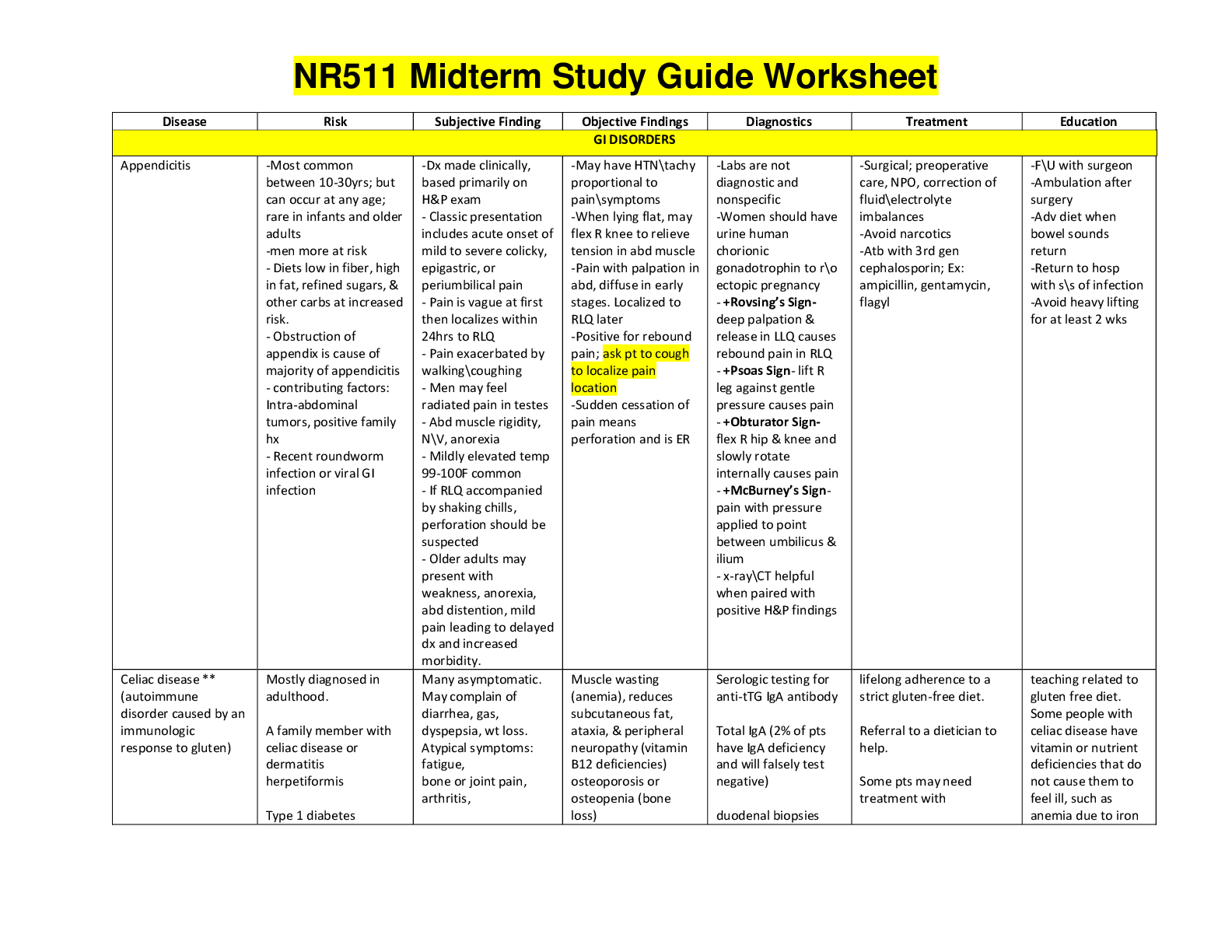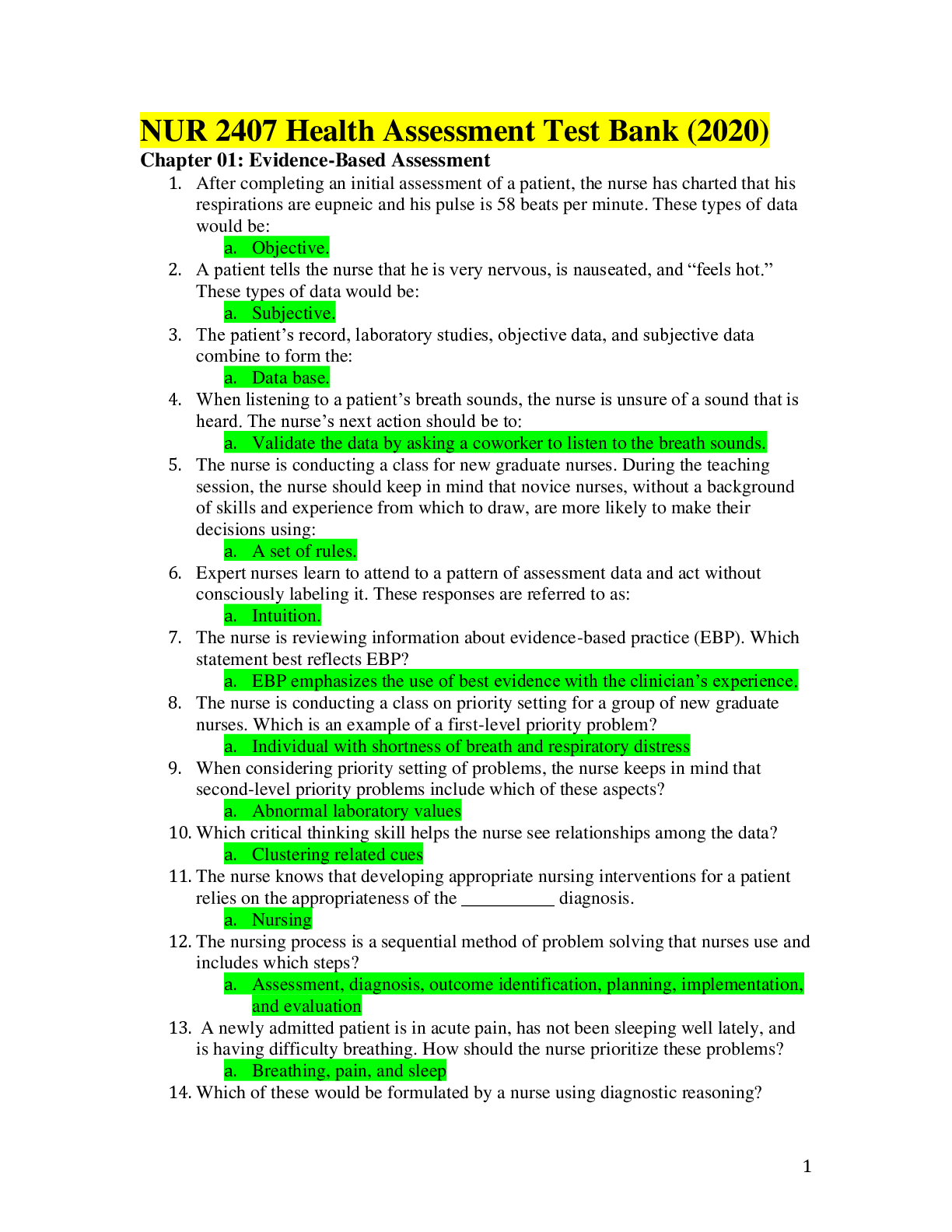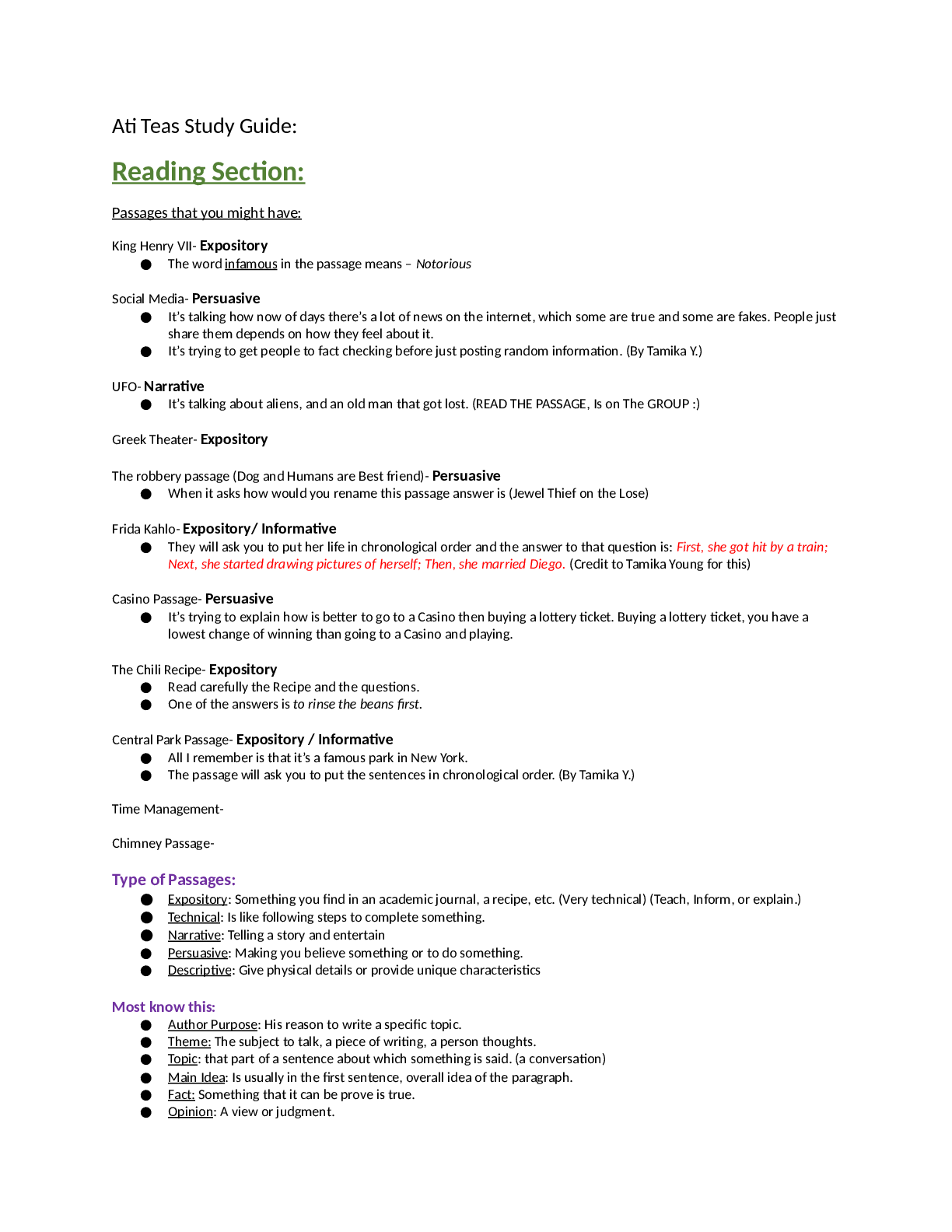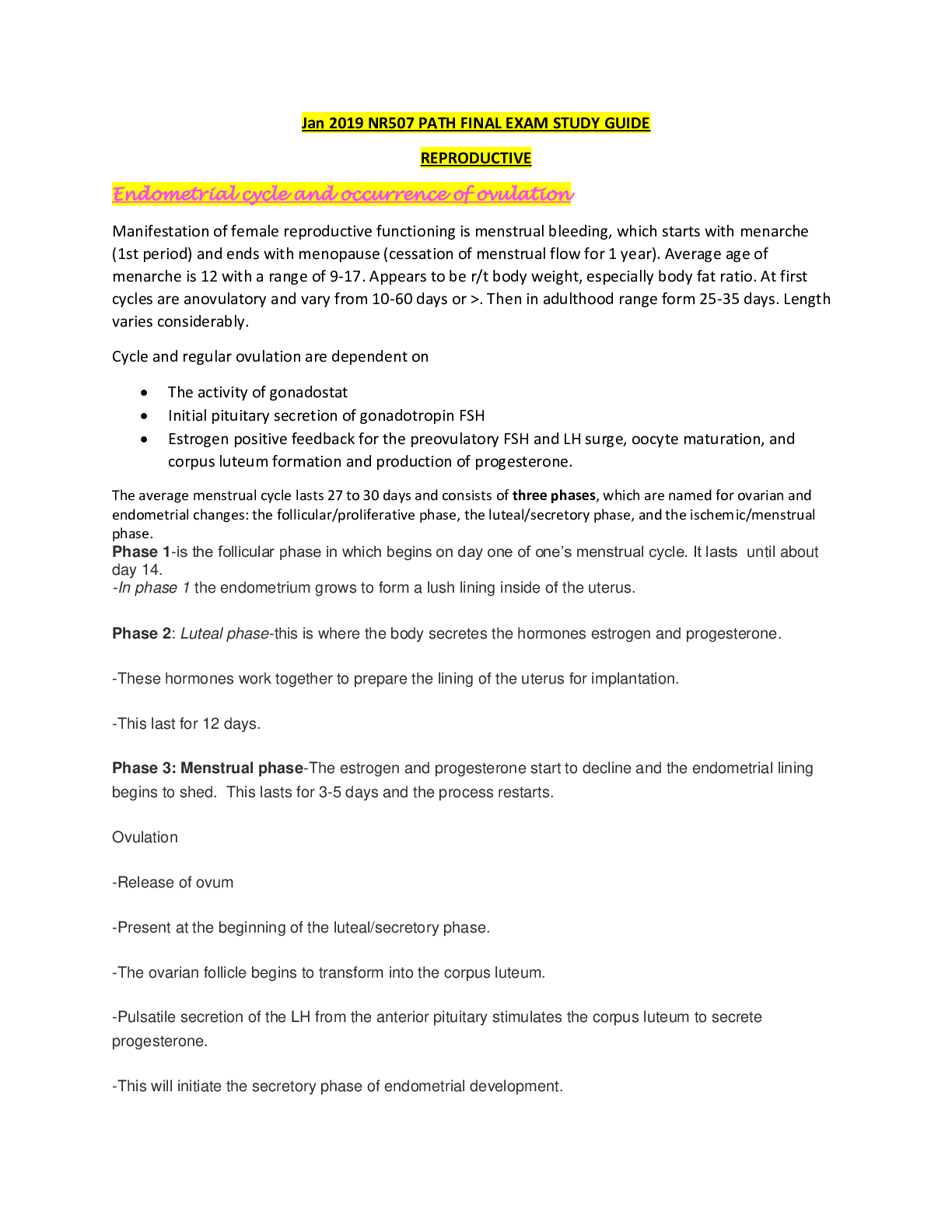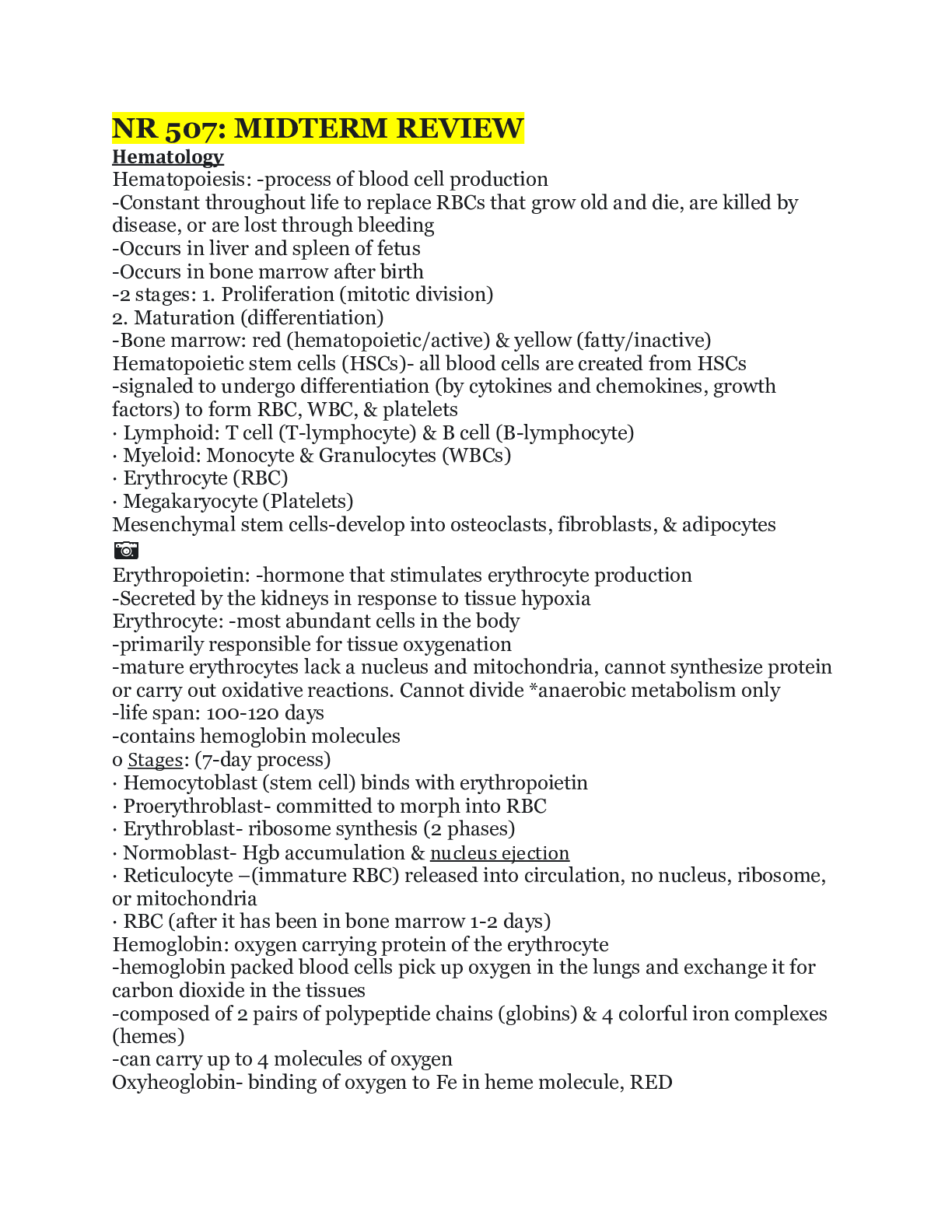*NURSING > STUDY GUIDE > Nursing 203 Adaptive Quizzing Test #1 Basic Concepts, Latest Guide 2019/20 (A+) (All)
Nursing 203 Adaptive Quizzing Test #1 Basic Concepts, Latest Guide 2019/20 (A+)
Document Content and Description Below
Adaptive Quizzing Test #1 Basic Concepts 1. The nurse is learning about nursing theories and their focus on the phenomena of nursing and nursing care. What would the nurse describe as a phenomenon ... of nursing? 2. The head nurse is teaching student nurses about internal and external variables related to the development of a disease. Which factors are considered external variables? 3. A 40-year-old patient is diagnosed with colon cancer. While interacting with the patient, the nurse learns that he has a twin brother. Which nursing actions are appropriate for the patient’s brother? 4. A hospital-based nurse has been asked to join a community-based nursing center. In what aspects does the community-based nursing center differ from a hospital setting? 5. While caring for a patient in the home, the nurse ensures a hygienic environment, a proper diet, and recreation. Which of Watson’s carative factors is the nurse following through this intervention? 6. Which intervention comes under active strategies of health promotion? 7. While working in a community health clinic, it is important to obtain nursing histories and get to know the patients. Part of history taking is to develop the nurse-patient relationship. Which statements apply to Peplau’s theory when establishing the nurse-patient relationship? 8. Which nurse is exemplifying a public health nursing practice? 9. The nurse is developing a PICOT question that addresses the effectiveness of hot fomentation in comparison with nonsteroidal anti-inflammatory drugs (NSAIDs) to relieve dysmenorrheal pain. Which is the intervention of interest in this research question? 10. Which factors enhance patient-centered care? 11. The nurse is caring for a patient who is quadriplegic. According to Maslow's hierarchy of needs, which patient needs should be given priority over others? 12. A 50-year-old patient is admitted with acute exacerbation of asthma. The patient is treated with bronchodilators and oxygen therapy. The patient is clinically stable and is planned for discharge. The nurse teaches the patient about deep breathing exercises. The nurse has initiated these exercises to improve the patient’s lung capacity. Which professional behavior is the nurse showing? 13. The nurse is developing a health promotion program on healthy eating and exercise for high school students using the health belief model as a framework. Which statement is related to the perception of susceptibility to an illness? 14. A professor at a nursing school asks students to give examples of secondary prevention. Which examples would the professor expect from the students? 15. A 50-year-old patient complains of hair loss. A scraping of the patient's scalp shows that the patient has a candida infection. The hair loss decreases with the use of a medicated shampoo and herbal oil. The nurse has developed a PICOT question and starts to search for evidence. Which should the nurse keep in mind while searching for evidence? 16. The nurse is employed in a health care setting and is responsible for immunizations. In which health care setting is the nurse working? 17. The nurse is studying the process of nursing research. Which research should the nurse classify as qualitative research? 18. The nurse is teaching the parents of a school-aged child about the risks of physical and sexual abuse and methods necessary to educate the child about them. Which level of Maslow’s hierarchy of needs is the nurse addressing? 19. A patient in labor has been brought to the certified nurse midwife (CNM). Which interventions should the CNM undertake in this situation? 20. A 41-year-old patient who underwent a craniotomy for the removal of a brain tumor 6 months ago comes to the clinic for a monthly follow-up visit. Which late effects of surgery should the nurse anticipate that the patient may possibly experience? 21. Health care reform will bring changes in the emphasis of care. Which of the following models is expected from health care reform? 22. A critical care nurse is using a computerized decision support system to correctly position her ventilated patients to reduce pneumonia caused by accumulated respiratory secretions. This is an example of which Quality and Safety in the Education of Nurses (QSEN) competency? 23. The nurses on an acute care medical floor notice an increase in pressure ulcer formation in their patients. A nurse consultant decides to compare two types of treatment. The first is the procedure currently used to assess for pressure ulcer risk. The second uses a new assessment instrument to identify at-risk patients. Given this information, the nurse consultant exemplifies which career? 24. The nurse has conducted an immunization program for physically challenged children in a rehabilitation center. Pneumonia vaccine was administered to the children as a part of the program. Which level of prevention is this? 25. community center is presenting a nurse-led program on the Patient Protection and Affordable Care Act. Which statement made by a participant indicates a need for further teaching? 26. Which activity performed by a nurse is related to maintaining competency in nursing practice? 27. A group of staff nurses notice an increased incidence of medication errors on their unit. After further investigation it is determined that the nurses are not consistently identifying the patient correctly. A change is needed quickly. What type of quality improvement method would be most appropriate? 28. A nurse is presenting information to a management class of nursing students on the topic of financial reimbursement for achievement of established, measurable patient outcomes. The nurse is presenting information to the class on which topic? 29. A nurse is using data collected from the unit to monitor the incidence of falls after the unit implemented a new fall protocol. The nurse is working in which area? 30. As an art, nursing relies on knowledge gained from practice and reflection on past experiences. As a science, what does nursing rely on? 31. Which of the following nursing activities is provided in a secondary health care environment? 32. The nursing staff is developing a quality program. Which of the following are nursing-sensitive indicators from the National Database of Nursing Quality Indicators (NDNQI) that the nurses can use to measure patient safety and quality for the unit? 33. Components of nursing metaparadigm: 34. A nurse ensures that each patient’s room is clean, well ventilated, and free from clutter, excessive noise, and extremes in temperature. Which theorist’s work is the nurse practicing in this example? 35. The nurse is caring for a patient admitted to the neurological unit with the diagnosis of a stroke and right-sided weakness. The nurse assumes responsibility for bathing and feeding the patient until the patient is able to begin performing these activities. The nurse in this situation is applying the theory developed by: 36. A nurse is caring for a patient who recently lost a leg in a motor vehicle accident. The nurse best assists the patient to cope with this situation by applying which of the following theories? 37. Which of the following categories of shared theories would be most appropriate for a patient who is grieving the loss of a spouse? 38. Which of the following types of theory influence the “evidence” in current “evidence-based practice (EBP)”? 39. Theory is essential to nursing practice because it: 40. Which of the following statements related to theory-based nursing practice are correct? 41. A nurse is presenting a program to workers in a factory covering safety topics, including the wearing of hearing protectors when workers are in the factory. Which level of prevention is the nurse practicing? A: Primary prevention 42. A patient had surgery for a total knee replacement a week ago and is currently participating in daily physical rehabilitation sessions at the surgeon’s office. In what level of prevention is the patient participating? 43. Based on the transtheoretical model of change, what is the most appropriate response to a patient who states: “Me, stop smoking? I’ve been smoking since I was 16!” 44. A patient comes to the local health clinic and states: “I’ve noticed how many people are out walking in my neighborhood. Is walking good for you?” What is the best response to help the patient through the stages of change for exercise? 45. A nurse is conducting a home visit with an older-adult couple. While in the home the nurse weighs each individual and reviews the 3-day food diary with them. She also checks their blood pressure and encourages them to increase their fluids and activity levels to help with their voiced concern about constipation. The nurse is addressing which level of need according to Maslow? 46. When taking care of patients, a nurse routinely asks if they take any vitamins or herbal medications, encourages family members to bring in music that the patient likes to help the patient relax, and frequently prays with her patients if that is important to them. The nurse is practicing which model? 47. After a class on Pender’s health promotion model, students make the following statements. Which statement does the faculty member need to clarify? 48. A male patient has been laid off from his construction job and has many unpaid bills. He is going through a divorce from his marriage of 15 years and has been seeing his pastor to help him through this difficult time. He does not have a primary health care provider because he has never really been sick and his parents never took him to a physician when he was a child. Which external variables influence the patient’s health practices? 49. The nurse assesses the following risk factors for coronary artery disease (CAD) in a female patient. Which factors are classified as genetic and physiological? 50. A nurse hears a colleague tell a nursing student that she never touches a patient unless she is performing a procedure or doing an assessment. The nurse tells the student that from a caring perspective: 51. Of the five caring processes described by Swanson, which describes “knowing the patient?” 52. A Muslim woman enters the clinic to have a woman’s health examination for the first time. Which nursing behavior applies Swanson’s caring process of “knowing the patient?” 53. A patient is fearful of upcoming surgery and a possible cancer diagnosis. He discusses his love for the Bible with his nurse, who recommends a favorite Bible verse. Another nurse tells the patient's nurse that there is no place in nursing for spiritual caring. The patient's nurse replies: 54. When a nurse helps a patient find the meaning of cancer by supporting beliefs about life, this is an example of: 55. An example of a nurse caring behavior that families of acutely ill patients perceive as important to patients' well-being is: 56. A nurse is caring for an older adult who needs to enter an assisted living facility following discharge from the hospital. Which of the following is an example of listening that displays caring? 57. Presence involves a person-to-person encounter that: 58. A hospice nurse sits at the bedside of a male patient in the final stages of cancer. He and his parents made the decision that he would move home and they would help him in the final stages of his disease. The family participates in his care, but lately the nurse has increased the amount of time she spends with the family. Whenever she enters the room or approaches the patient to give care, she touches his shoulder and tells him that she is present. This is an example of what type of touch? 59. A nurse enters a patient’s room, arranges the supplies for a Foley catheter insertion, and explains the procedure to the patient. She tells the patient what to expect; just before inserting the catheter, she tells the patient to relax and that, once the catheter is in place, she will not feel the bladder pressure. The nurse then proceeds to skillfully insert the Foley catheter. This is an example of what type of touch? 60. Which of the following is a strategy for creating work environments that enable nurses to demonstrate more caring behaviors? 61. A nurse is talking with a young-adult patient about the purpose of a new medication. The nurse says, “I want to be clear. Can you tell me in your words the purpose of this medicine?” This exchange is an example of which element of the transactional communication process? 62. A nurse prepares to contact a patient’s physician about a change in the patient’s condition. Using SBAR (Situation, Background, Assessment, and Recommendation) communication, which of the following is the correct order? 1.“She is a 53-year-old female who was admitted 2 days ago with pneumonia and was started on Levaquin at 5 pm yesterday. She complains of a poor appetite.” 2. “The patient reported feeling very nauseated after her dose of Levaquin an hour ago.” 3. “Would you like to make a change in antibiotics, or could we give her a nutritional supplement before her medication?” 4. “The patient started complaining of nausea yesterday evening and has vomited several times during the night.” 63. A nurse is assigned to care for a patient for the first time and states, “I don’t know a lot about your culture and want to learn how to better meet your health care needs.” Which therapeutic communication technique did the nurse use in this situation? 64. A nurse has been gathering physical assessment data on a patient and is now listening to the patient’s concerns. The nurse sets a goal of care that incorporates the patient’s desire to make treatment decisions. This is an example of the nurse engaged in which phase of the nurse-patient relationship? 65. A nursing student is reviewing a process recording with the instructor. The student engaged the patient in a discussion about availability of family members to provide support at home once the patient is discharged. The student reviews with the instructor whether the comments used encouraged openness and allowed the patient to “tell his story.” This is an example of which step of the nursing process? [Show More]
Last updated: 2 years ago
Preview 1 out of 8 pages

Buy this document to get the full access instantly
Instant Download Access after purchase
Buy NowInstant download
We Accept:

Reviews( 0 )
$10.00
Can't find what you want? Try our AI powered Search
Document information
Connected school, study & course
About the document
Uploaded On
Nov 22, 2019
Number of pages
8
Written in
Additional information
This document has been written for:
Uploaded
Nov 22, 2019
Downloads
0
Views
98

